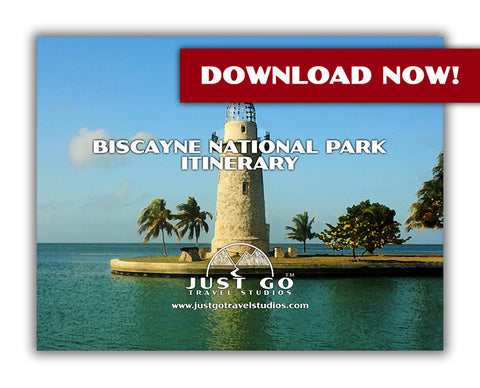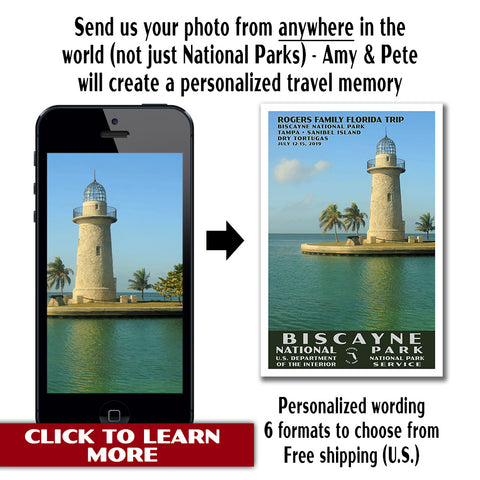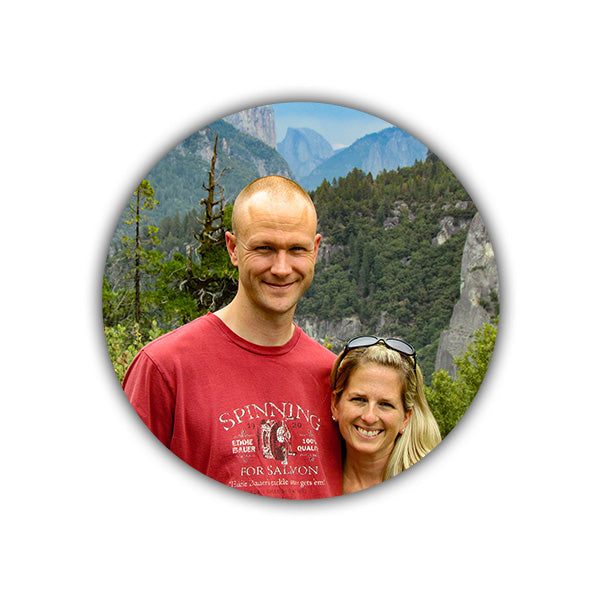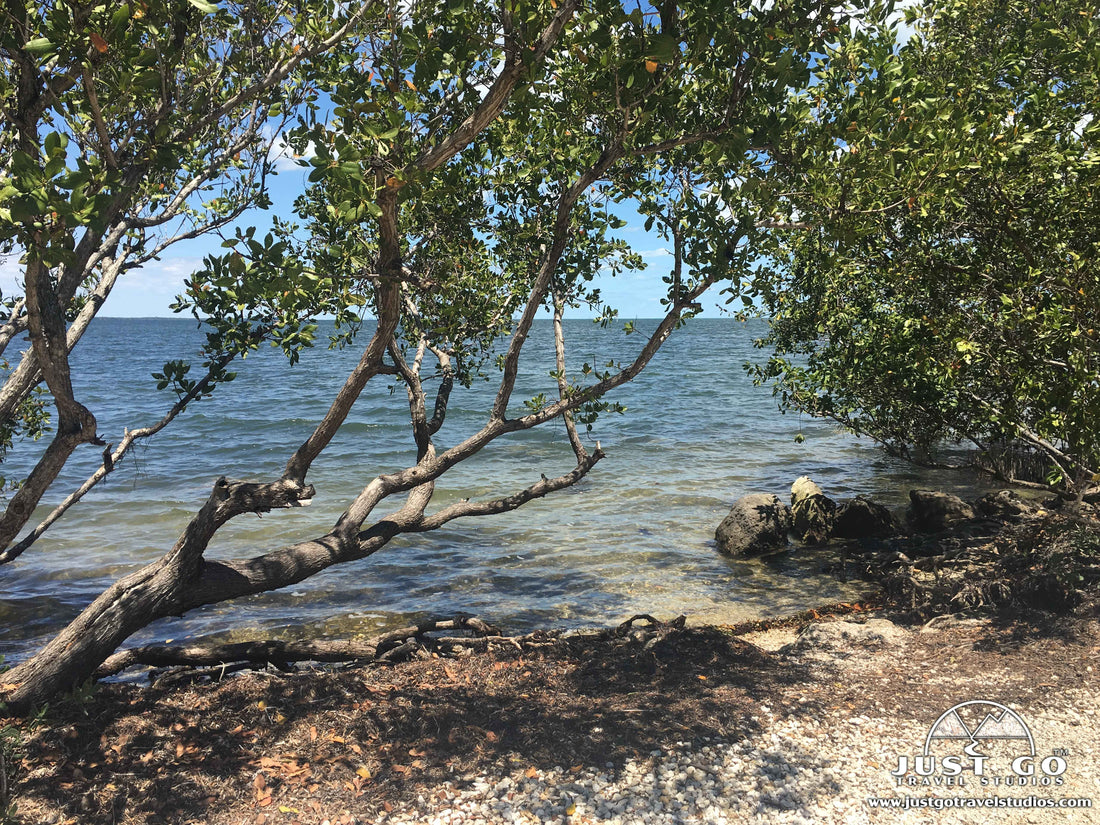
Biscayne National Park: Things to Do, Hiking Trails, Tours, Maps, Fees & More
Peter BrahanMany people flock to Florida each year to escape the cold weather, but only about 650,000 visitors make their way to beautiful Biscayne National Park. Since the park is over 95% water, it’s not surprising to know that more than half of all visitors come in by boat (source) rather than by automobile.
If you don’t happen to own a watercraft (or have it with you when visiting Florida), don’t worry! There are a few things to near the visitor center without leaving land, or you can join the other 22,000 visitors per year that take one of the guided tours offered in the park.
While the park has seen solid attendance levels hovering near the half-million mark since 2001, many stay on the water. In fact, only about 50,000 visitors per year end up entering the visitor center. This makes the park not seem overly crowded when visiting.
If you are a National Park fan and plan on heading to Florida, it’s likely you have Everglades National Park or perhaps even Dry Tortugas National Park on your itinerary, but make sure you visit Biscayne. Even if you only have a half-day, it’s more than worth the time and effort and if you take the time to learn about the park and the habitat, we’re certain that you won’t be disappointed!
There are a lot of options and things to do in Biscayne, so before your trip make sure you download our Biscayne National Park itinerary. We cover what to see and do on land and on the water. We also cover where to stay, what to pack and what to do in the area!
BISCAYNE NATIONAL PARK HISTORY
Biscayne National Park has an interesting past. It was originally supposed to be part of Everglades National Park. Those plans were scrapped as it put the establishment of Everglades National Park at risk.
In 1968 it became Biscayne National Monument, amidst nearby development and nearly being swallowed into a massive city-like atmosphere, similar to Miami. Some of the scars on the land from that effort exist today (see below). In 1980, it received designation as Biscayne National Park.
FUN FACTS ABOUT BISCAYNE NATIONAL PARK
- Since the park is over 95% water, it’s one of the few parks where the main attractions are underwater. This includes coral reefs, shipwrecks and a variety of marine life.
- Biscayne National Park has some of the largest protected mangrove forests. These help to protect the coastline by reducing erosion and creating a habitat for wildlife.
HOW TO GET BISCAYNE NATIONAL PARK
Located on the Atlantic Coast of Florida, Biscayne National Park is quite easy to get to and can also be easily coupled with other popular vacation destinations.
The visitor center is located in Homestead, FL, though it is 10 miles east of the main part of the city at the end of SW 328th St.
- Directions from Homestead, FL to Biscayne National Park (this will take about 30 minutes and is smooth going outside of the Homestead city limits).
- Directions from Miami, FL to Biscayne National Park (this will take between 1 hour and 90 minutes, depending on traffic).
- Directions from Everglades National Park to Biscayne National Park (this will take about 40 minutes, with the only likely traffic to be while passing through Homestead, FL).
- Directions from Key West, FL to Biscayne National Park (this will take over 3 hours, depending on traffic).
If you are coming into the area by airplane, then there are several major airports nearby, including Miami and Fort Lauderdale. If you are in for a bit of a longer drive, then Tampa, FL, Fort Myers and Orlando are also viable options, but the drives will be over 3 hours long from each of those airports.
BISCAYNE NATIONAL PARK: MAINLAND AREA

Mainland and Visitor Center map, courtesy of the National Park Service
While most of the park is located away from the mainland, the Dante Fascell Visitor Center and surrounding area is still the heart of the park. Visitors come here to check out the visitor center, take a short walk or begin a guided tour.
When visiting the main park entrance area, our recommendations include:
Dante Fascell Visitor Center
The visitor center is relatively small, but there are some great exhibits about the area covering the geography, local animals and history of the park. There is a short film as well as a small art gallery. We found the rangers here to be extremely helpful when we visited, and the fact that the park is not crowded allowed us plenty of time to ask questions without feeling rushed.

Hiking
Believe it or not, even though the park is 95% water, there is are several options for hiking in the park, including some that are right from the mainland. Options include:
Jetty Trail
- Difficulty: Easy
- Distance (round-trip): 1.3 miles
- Elevation gain: Minimal
- Hiking time (approximate): 30 to 45 minutes
- Trail type: Out-and-back
- Potential hazards: Bugs, sun exposure
- Restrooms: Flush toilets located at the trailhead.
- Recommended footwear: Sandals or closed-toed shoes
- Pets: Not allowed
Trail Description
This flat trail is a 1.3-mile (round-trip) walk over bridges, through a mangrove lined shore out to the jetty. The trail is half-boardwalk and half packed gravel. Along the way you’ll have great views of the surrounding water and be able to check out boast coming in and out of the visitor center area. It is a great way to start or finish the day!
Trailhead Directions
The trail begins right at the Dante Fascell Visitor Center.
Black Creek Canal Trail
- Difficulty: Easy
- Distance (round-trip): 1.7 miles
- Elevation gain: Minimal
- Hiking time (approximate): 45 minutes
- Trail type: Out-and-back
- Potential hazards: Bugs, sun exposure
- Restrooms: Flush toilets located at the trailhead.
- Recommended footwear: Sandals or closed-toed shoes
- Pets: Not allowed
Trail Description
The paved, out-and-back trail is an extension of a longer biking and walking trail. After walking through a mangrove shoreline, the view at the end of the jetty is incredible!
Trailhead Directions
The trail starts at the end of SW 87th Ave on the north side of the Black Creek Canal in Black Point Park. This is about 20 minutes north of the Dante Fascell Visitor Center.


BISCAYNE NATIONAL PARK: GUIDED TOURS AND SELF-GUIDED ACTIVITIES
There are a number of activities or tours that are managed by the National Park Institute. You can of course do many of these activities on your own, including boating, snorkeling, kayaking and fishing. If you are looking for a guided activity, the Biscayne National Park Institute does an outstanding job of managing and delivering these experiences. Some options include:
Kayaking and Canoeing (self-guided)
Kayaking or canoeing are great ways of getting out on the water without much cost at all (that is, if you have your own watercraft). You can put in at several spots in the park, including right near the visitor center. If you want to paddle and camp on the islands overnight, you can get a free overnight parking permit at the visitor center. Paddling guides and maps are available on the NPS website. Be sure to check the weather conditions ahead of venturing out, as weather around here can be harsh if you aren’t prepared.
Paddling Tours
We loved getting out on the water with two of the naturalists at the Biscayne National Park Institute. They were extremely knowledgeable, friendly and answered a ton of questions from both the adults and kids alike. Adventures include snorkeling, paddling and even stand up paddle boarding. We went on the Jones Lagoon Eco Adventure and absolutely loved it. Only small groups are allowed, making this a very special experience. For more information on what is offered, check out the paddling adventures offered by the Institute. If you plan on taking a tour, make sure you book well ahead of your travel, as spots can fill up fast and well in advance. Don’t expect to stroll up to the counter and have availability (though this can happen).

Boating
Boating is one of the most popular activities, and many enter the park on boat. Be respectful of speed limits and areas where you are not allowed to be (they are well marked).


Island Visits
There are several islands off the coast that are able to be accessed via private watercraft of by tour. The Biscayne National Park Institute offers island tours of Boca Chita Island or a lighthouse tour. Check out more information on the Biscayne National Park Institute page on boating.
BISCAYNE NATIONAL PARK: BOCA CHITA KEY

Boca Chita Key map, courtesy of the National Park Service
The most popular of the islands to visit in Biscayne National Park is Boca Chita Key. The island is extremely picturesque. The main attraction is the lighthouse, although the island in general is very relaxing and a great place to spend the day. There is also an open-air picnic area in this island. Boca Chita Key is about 11 miles one-way from Convoy Point (which is near the visitor center).
Our recommendations for Boca Chita Key (and the surrounding area) include:
Boca Chita Lighthouse
The Boca Chita Lighthouse is 65 feet tall with an observation deck. For the top of the lighthouse there are great views of Miami and the surrounding landscape. The deck may be open (if it is staffed by park employees). This is usually the case between September and May.

Boca Chita Lighthouse, courtesy of the National Park Service
Stiltsville
Stiltsville is a set of small shacks built on stanchions in the water. It is about 10 miles north of Boca Chita Key. Only a few of the original 27 structures remain after multiple large storms came through and left quite a bit of destruction behind.

Stiltsville, photo courtesy of Pallowick
Hiking
BOCA CHITA TRAIL
- Difficulty: Easy
- Distance (round-trip): 0.8 miles
- Elevation gain: Minimal
- Hiking time (approximate): 30 minutes
- Trail type: Loop
- Potential hazards: Bugs, sun exposure
- Restrooms: Flush toilets located at the trailhead.
- Recommended footwear: Sandals or closed-toed shoes
- Pets: Not allowed
Trail Description
This easy trail provides access to the entire island. The hike passes over a bride-be sure to look under the bridge, as fish commonly gather underneath!
Trailhead Directions
The trailhead starts near the restrooms in the harbor.
BISCAYNE NATIONAL PARK: ELLIOTT KEY
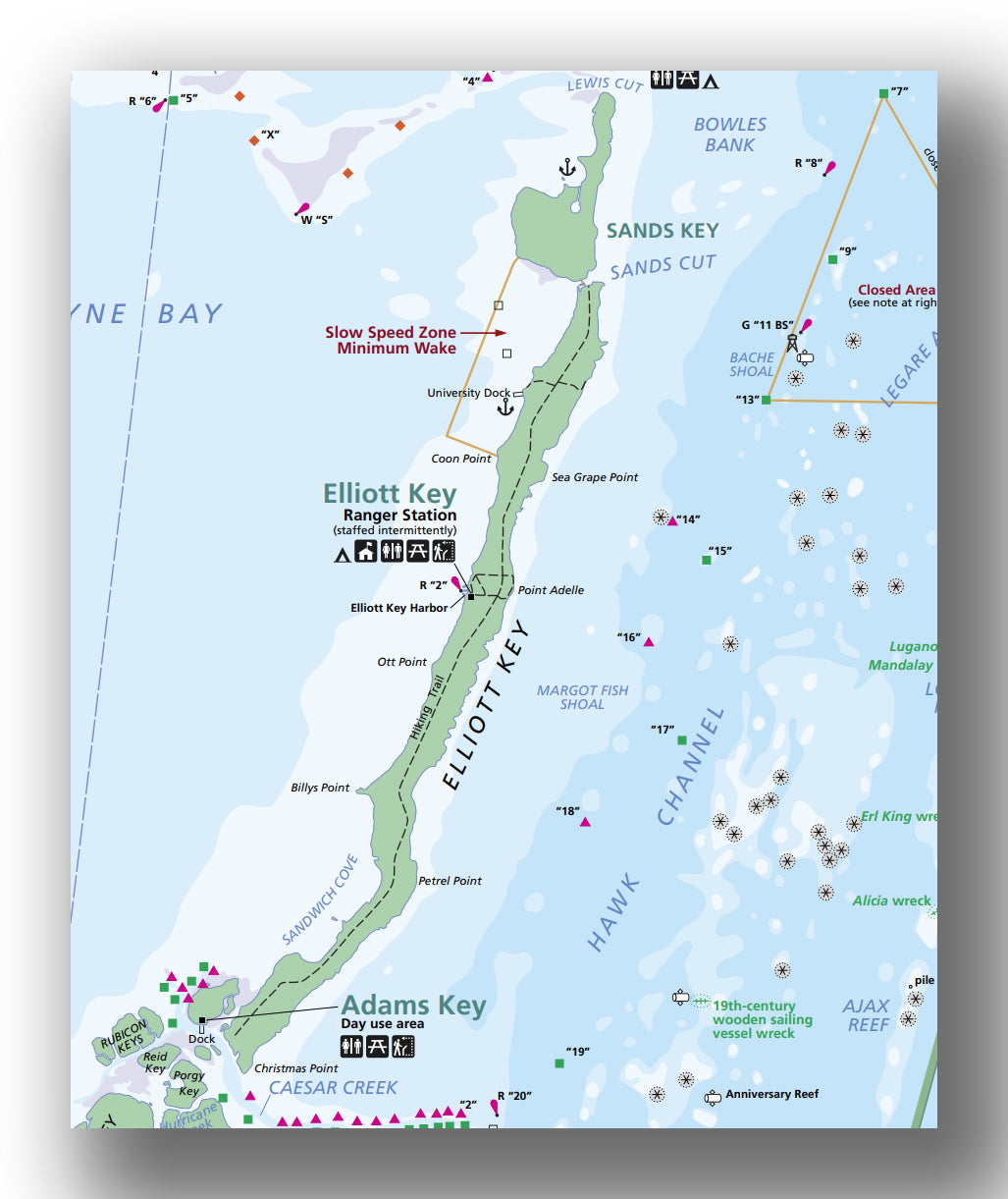
Eliott Key map, courtesy of the National Park Service
Elliott Key is the largest of the islands in Biscayne National Park. It is located about 9 miles from the visitor center. Elliott Key is not as crowded as Boca Chita Key, and it is a bit more family-friendly as Boca Chita Key is a popular place to for adults to hang out on weekends and holidays
Hiking
The trails on Elliott Key are worth going on if you are in the area, but they are not the main reason for visiting the island. If you have the time, here are the two trails worth considering:
ELLIOT KEY LOOP TRAIL
- Difficulty: Easy
- Distance (round-trip): 1.1 miles
- Elevation gain: Minimal
- Hiking time (approximate): 30 minutes
- Trail type: Loop
- Potential hazards: Bugs, sun exposure
- Restrooms: Flush toilets are located in the harbor near the ranger station
- Recommended footwear: Sandals or closed-toed shoes.
- Pets: Not allowed

Elliot Key Loop Trail map, courtesy of the National Park Service
Trail Description
This loop trail travels from across the island before reaching a boardwalk on the opposite side of the island and returning back to the harbor.
Trailhead Directions
The trailhead starts at Elliott Key Harbor, just past the ranger station.
SPITE TRAIL
- Difficulty: Easy
- Distance (round-trip): 14 miles
- Elevation gain: Minimal
- Hiking time (approximate): 7 hours
- Trail type: Out-and-back
- Potential hazards: Bugs, bugs and more bugs
- Restrooms: Flush toilets are located in the harbor near the ranger station
- Recommended footwear: Closed-toed shoes
- Pets: Not allowed
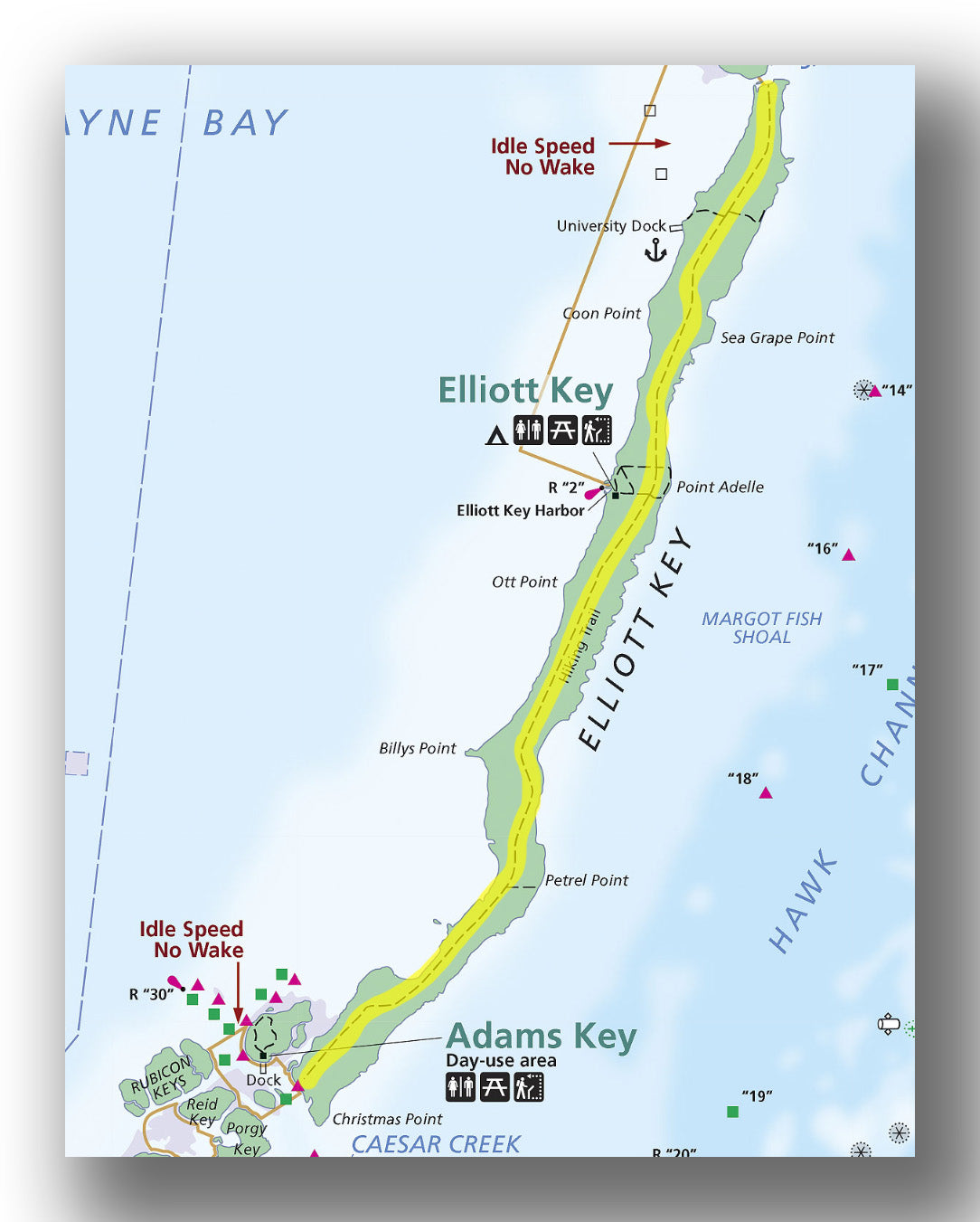
Spite Trail map, courtesy of the National Park Service
Trail Description
This trail is what is left of a six-lane swath of trees cut out on the island in an attempt to prevent the land from being preserved (which obviously failed!). The flat trail travels the length of the island.
Trailhead Directions
The trailhead starts at the northern end of the island, though most hikers typically start from the Elliott Key Loop Trail, located just slightly to the north of the middle of the island.
BISCAYNE NATIONAL PARK: ADAMS KEY

Adams Key map, courtesy of the National Park Service
Adams Key is on the southern side of Elliott Key, located about 8 miles from Convoy Point. This small island is best for picnicking and enjoying the outdoors, but since the island is small there isn’t a ton to explore. The island is only open during the daylight hours. If you are planning on kayaking, this makes a great home base. One nice thing in particular about Adams Key is how quiet it is compared to the other islands, particularly Boca Chita Key.
Jones Lagoon
Jones Lagoon has very calm and clear waters, making it an ideal place for kayaking or stand-up paddle boarding. We really enjoyed our time in this remote part of the park!


Hiking
ADAMS KEY LOOP TRAIL
- Difficulty: Easy
- Distance (round-trip): 0.5 miles
- Elevation gain: Minimal
- Hiking time (approximate): 15 to 20 minutes
- Trail type: Loop
- Potential hazards: Bugs, sun exposure
- Restrooms: Flush toilets are located at the day-use area
- Recommended footwear: Sandals or closed-toed shoes
- Pets: Not allowed
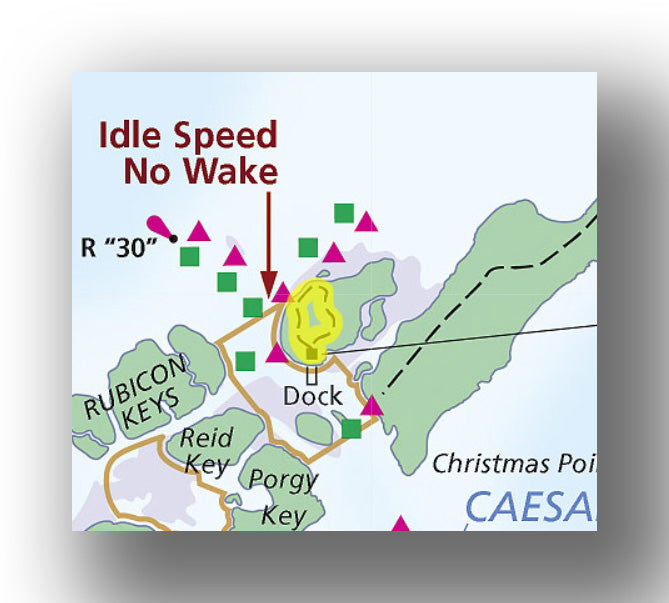
Adams Key Loop Trail map, courtesy of the National Park Service
Trail Description
The Adams Key Loop Trail is a short trail that travels through the woods around the island. It starts from the two dwellings used by the National Park Service Rangers. The 0.5-mile loop is easy, but unless you have extra time, we recommend skipping it.
Trailhead Directions
The trailhead starts near the two dwellings used by the National Park Service for rangers.
WHERE TO STAY IN BISCAYNE NATIONAL PARK
Biscayne National Park Lodging: There is no lodging inside of the park. There are plenty of options in nearby Homestead, FL to the west or in Miami, FL to the north. Reservations are typically not too hard to find, but we still recommend booking a place in advance.
Camping in Biscayne National Park: There are two campgrounds inside of Biscayne National Park: one on Elliott Key and the other on Boca Chita Key. They are on a first-come, first-served basis. You can also see more information on camping in Biscayne National Park here.
BEST TIME TO VISIT BISCAYNE NATIONAL PARK
Biscayne National Park is good to visit at all times of year, though you need to be careful of potential hurricanes in the fall and also extreme heat in the summertime. If we had to pick, we’d recommend visiting between January and April. The crowds do pick up in March, but this allows the best balance of quiet and the best weather.

Average high and low temperatures in Biscayne National Park

WHAT TO BRING TO BISCAYNE NATIONAL PARK
- Since there is little protection from the sun, you need to make sure you bring sunblock. Since there are coral reefs off the coat, we really recommend something that is reef-friendly like Sun Bum Reef Safe sunblock. It works great and you’ll feel good about using it as well.
- Sunglasses and a hat!
- You absolutely need to bring a good bug spray to this park. They really can be harsh, so be prepared!
- We don’t like to pack large towels, so these small microfiber towels worked out really well.
- If you are on the water, make sure you bring protection for your phone!
OTHER INFORMATION ON BISCAYNE NATIONAL PARK AND THE SURROUNDING AREA
- Amy and Derek (from “Parks and Points”) has a terrific post on the rest of the parks and preserves that Florida has to offer.
- Carrick (from “Along for the Trip”) has a great blog on Biscayne National Park and why it’s a great place to visit now.
- Kelly (from “Kelly of the Wild”) talks about snorkeling in Biscayne National Park and her adventures in their recent blog.
- If you are boating or planning on enjoying the water, be sure to check out the information on weather and tidal charts in Key Biscayne from US Harbors.
RELATED INFORMATION ON BISCAYNE NATIONAL PARK AND THE SURROUNDING AREA FROM JUST GO TRAVEL STUDIOS
- Be sure to check out our Biscayne National Park itinerary. It is a .pdf download that offers further information about what to see and do (and pack) for your visit. Since cell service isn’t great in the park, having information in hard-copy is extremely useful! You can also check out our blog on Camping in Biscayne National Park!
- Nearby Biscayne National Park is Everglades National Park and Big Cypress National Preserve. Both of the parks are worth checking out and you can spend a day or two in each of them without any problem at all.
- Interested in a memory of your trip? Be sure to check out our Biscayne National Park poster.
- After your trip, let us take one of your photos and turn them into a custom, vintage travel poster. We love creating these lasting memories for you!

